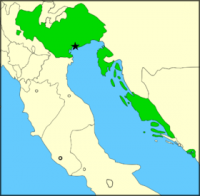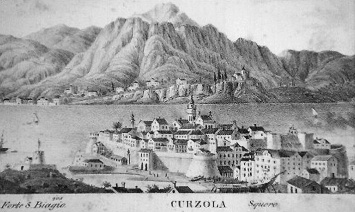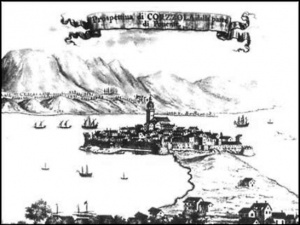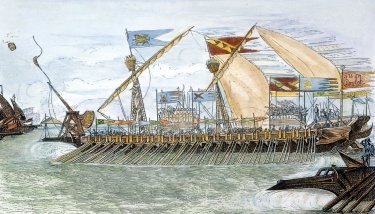Difference between revisions of "User talk:Peter Z./History Notes 3"
(work) |
|||
| Line 32: | Line 32: | ||
[[File:Blato Graves.jpg|thumb|right|325px|One of the old graves in Blato (Korcula) written in Italian. Photo by [[Directory:Peter Zuvela|Peter Zuvela]]]] | [[File:Blato Graves.jpg|thumb|right|325px|One of the old graves in Blato (Korcula) written in Italian. Photo by [[Directory:Peter Zuvela|Peter Zuvela]]]] | ||
| − | To-days Korčula was proberly originally a Greco-Roman town. It became a dual [[Latin]] Roman-Slavic town in the middle ages. With the arrival of Venetians in the 15th century it continued to evolve as such until the end of the Republic itself in 1797. The town's old centre is of Venetian construction <ref>[http://www.1911encyclopedia.org/Curzola Encyclopaedia Britannica (publ. 1911)]</ref> and many have pointed out its similarities to Venetian architecture. Today we have surnames on the island that are not of Slavic origin, for example: | + | To-days Korčula was most proberly originally a Greco-Roman town. It became a dual [[Latin]] Roman-Slavic town in the middle ages. With the arrival of Venetians in the 15th century it continued to evolve as such until the end of the Republic itself in 1797. The town's old centre is of Venetian construction <ref>[http://www.1911encyclopedia.org/Curzola Encyclopaedia Britannica (publ. 1911)]</ref> and many have pointed out its similarities to Venetian architecture. Today we have surnames on the island that are not of Slavic origin, for example: |
* Izmaeli - originally de '''Ismael''' | * Izmaeli - originally de '''Ismael''' | ||
* Gabrijeliċ - originally '''Gabriel''' | * Gabrijeliċ - originally '''Gabriel''' | ||
Latest revision as of 09:11, 20 December 2012
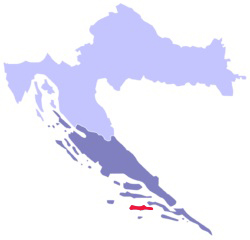
History
The indigenous population of Korčula (in Croatian the c in Korcula is pronounced ch and is written "č") were Mesolithic and Neolithic peoples. Archaeological evidence has been found at Jakas Cave near the village of Zrnovo and on the west end of the island in a cave called Vela Spila. [1] The island was then settled by Illyrians. [2] A Greek colony was founded on Korčula. [3] Greek colonists from Issa (Vis) formed a small colony on the island in the 4th or 3rd century B.C.
The Lumbarda Psephisma is a stone inscription which documented the event and was found on the island of Korčula.[4] The Greeks (from Issa-Vis) established a settlement on the basis of a prior agreement with the representatives of the local Illyrians who were Pil and his son Daz. A literary work from the 1st century AD "Periegesis Hellados" [5] mentions a second Greek Cnidian colony on the island of Nigra Kerkyra (Korčula).[6] According to Nikola Ostojic the Greeks named it Corcira Melaena meaning Black Corfu after their homeland and the dense woods on the island. It is not known what the Illyrians called the island.
The island became part of the Roman province of Illyricum.[7] The Romans called the island Corcyra Nigra. After the Illyrian Wars, Roman migration followed and Roman citizens arrived on the island.[8] The Illyrian population immediately after the Illyrian Wars suffered greatly under the Romans. A large portion of the Illyrians were executed and sold off to slavery.[9]
In 10 AD Illyricum was split into two provinces, Pannonia and Dalmatia.[10] Korčula became part of the ancient Roman province of Dalmatia. In the 6th century it came under the Eastern Roman Empire-Byzantine (by then the Greek families would have been Romanized). Slavic raids started in the late 6th and by the late 8th century, started to settle in the Roman Dalmatian region. The term Slav was first used by the Byzantines (i.e., Procopius-Byzantine scholar, Jordanes- 6th century Roman bureaucrat) and was recorded in the 6th century (cia. 550). It is believed the Neretljani Slavs invaded the island and occupied it. The Old-Slavic term for Korčula was Krkar.[11] The Ostrogoths (a Germanic tribe related to the Goths) also invaded Dalmatia in the 6th century. According to Nikola Ostojic, the Roman families survived. They spoke the Latin Romance language - Dalmatian. The Narantani, who are referred to today mainly as Neretljani, were a nation of pirates. Firstly known as Arentanoi.[12] Modern scholarly research now puts the time of the invasion of the Slavic tribes in the region to be much later.
Danijel Dzino states that the 19 century theories of mass movements of people into the old Roman Province of Dalmatia are questionable. Modern Archaeological and Scholarly research seems to be saying that we are looking at much smaller groups of Slavs and Avars invading the region. The term Slav was first used by the Byzantines and was written in the 6th century in Greek (Σκλαβῖνοι-Sklabenoi). Later in Latin it was written Sclaveni. According to Danijel Dzino the term Slavs was first used by outside observers of the day to describe the newcomers. The Slavs used the term to describe themselves at a later stage. Thus began the construct identity of the new arrivals. Later the Slavic peoples started to identify themselves and separated (or were separated by others) into different groups.[13] Archaeological evidence found in the old Roman city of Salon and in particularly the artefacts found at the Old Croatian grave sites [14] in Dalmatia (during recent excavations) seems to confirm this. Some historians have placed the arrival of Slavs (in larger groups) now to be more in the region of the late 8th century or even early 9th century.[15][16] In Korčula's case a small group of Slavs (Chakavian speakers) did settled on the island in 9th century. The new population of Slavs probably settled in the centre of the island and they spoke old Chakavian-Croatian. The centre of the island had its strategic qualities which allowed protection on all sides from attack by sea. It also had fertile land which allowed cultivation.
Conquered by the Republic of Venice under the management of the doge Pietro Orseolo from 999 to 1100. The Venetian called the island Curzola. Held by the Genoese from 1100 to 1129. Recaptured by Popone Zorzi, from the Republic of Venice and ruled from 1129 to 1180, from 1252 to 1254, and from 1258 until 1357.
Raska a medieval principality tries to invade Korčula. Miroslav, Stracimir and Stefan Nemanja (c. 1114 – 13 February 1199) were 12th-century Serbian royalty, heir to the Vukanovic dynasty and Grand Prince of medieval Raska from 1166 to 1196. [17] The counts wanted to conquer Korčula and near by Ragusa (Dubrovnik)[18]Stracimir with a strong army, in 1181 landed in a faraway part of the city and began to attack the island but failed.
Statute of Korčula was drafted in 1214. The Statute itself [19] was written by Latin-Roman Dalmatian & Slavic nobility. [20][21][22] Possessed on behalf of the king of Hungary from 1257 and with brief interruptions of the Genoese until 1418.
Devoting itself of its own accord to the Republic of Venice in 1420. Korčula was devastated by the plague in 1529 and 1558.[23][24] Surrendered with the Republic of Venice to France in 1797 (It was occupied by the Russians for a year in 1808.). British rule from 1813 to 1815 under the command of Peter Lowen.
Occupied by Austria, first by obligation from 1797 to 1806, later by the Vienna Treaty from 1815 to 1918. The last Italian government school was abolished in Korčula on the 13th of September 1876.[25] In the neighbouring Kingdom of Croatia-Slavonia a Croatian nationalistic movement was established and alongside that, within the Balkan region a Pan-Slavic movement was growing (the beginnings of the ill fated Yugoslavia). These political on goings started to be felt in the Kingdom of Dalmatia. The Austrians in the 1860s started to introduce (a process of Croatisation) within the Kingdom of Dalmatia a standardised Croatian language sometimes referred to as Illirski. It then replaced Italian altogether. In effect the government undertook culture genocide. For centuries the Italian language was the official language of the Dalmatian establishment. It was also the spoken language in white-collar, civil service and merchant families. Privately Italian schools were still being run in the Kingdom of Dalmatia, i.e the city of Zadar and Split (Lega Nazionale at Spalato).[26] Under the Treaty of Rapallo (Nov. 12, 1920 between Italy and Kingdom of Serbia, Croatia & Slovenia.),[27] Korčula became part of the Kingdom of Serbia, Croatia & Slovenia which was renamed Kingdom of Yugoslavia in 1929. After World War II Dalmatia was divided between three republics of Communist Yugoslavia. Most of the territory went to Croatia. In 1991 Korčula became part of the independent Republic of Croatia.
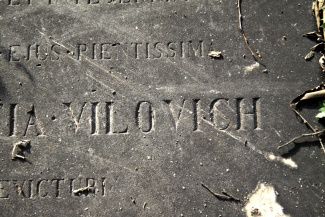
To-days Korčula was most proberly originally a Greco-Roman town. It became a dual Latin Roman-Slavic town in the middle ages. With the arrival of Venetians in the 15th century it continued to evolve as such until the end of the Republic itself in 1797. The town's old centre is of Venetian construction [28] and many have pointed out its similarities to Venetian architecture. Today we have surnames on the island that are not of Slavic origin, for example:
- Izmaeli - originally de Ismael
- Gabrijeliċ - originally Gabriel
- Đunio - originally de Giunio
- Bonguardo
- Depolo
- Sambrailo
- Jakov Baničević - originally Jacobus Bannissius
- Don Marko Bono of Žrnovo
- D'Angelis
- Sessa
- Bernardi
- Fabris [29]
- Vidali - surname of a noble family from the 16th century. [30]
- Buskariol
Statement by Croatian Historian Sime Peričić:
| “ | It is true, then a small colony of Italians where in Sibenik, on the island of Korcula, Hvar and Vis, and other places of the province.[31] | ” |
In the 19th century the island became heavily influenced by Pan-Slavism and the Croatian Nationalistic movements. Pan-Slavism was later in the 20th century reinforced by the Yugoslavian governments. The Communist Yugoslavian regime (1945-92) had a huge influence on the island of Korčula and the historic region of Dalmatia. The Yugoslav Communist party [32] was the main driving force in all social matters within the former Yugoslavia. Its Stalinist policies from the 1940s to the 1960s and authoritarian rule [33] have been mostly ignored in the Western media. From the late 19 century onwards the Dalmatian Italians culture has all but disappeared from the region.
There needs to be an historical reassessment.
Romanized Slavs
Dalmatians of Roman ancestry and the Republic of Venice brought Mediterranean cultural to the Slavs. Christianity was one aspect of this. In essence Slavs on the island were Romanized (adopted Latin culture).
Recent DNA studies have stated that more than three quarters of today's Croatian men are the descendants of Europeans who inhabited Europe 13 000-20 000 years ago. The first primary source (factual-that its authenticity isn't disputed) to mention the Croatian-Hrvat identity in the Balkans was Duke Branimir (Latin: "Branimiro comite dux cruatorum cogitavit" c. 880 AD). Branimir was a Slav from Dalmatia. [34]
Later the Slavic peoples started to identify themselves and separated (or were separated by others) into different groups. It seems that in Southern Dalmatia the Slavic identity lasted much longer. As centuries went by Dalmatian Slavs started to identify themselves as just Dalmatians.
Historic quote taken from Researches on the Danube and the Adriatic written by Andrew Archibald Paton in 1861. Chapter 4 - The Dalmatian Archipelago on page 164.
- Signor Arneri from the town of Korčula stated:
| “ | These three pears you see on the wall," said he, "are the arms of my family. Perussich was the name, when, in the earlier part of the fifteenth century, my ancestors built this palace; so that, you see, I am Dalmatian. All the family, fathers, sons, and brothers, used to serve in the fleets of the Republic (Editors notes: Republic of Venice); but the hero of our race was Arneri Perussich, whose statue you see there, who fought, bled, and died at the Siege of Candia,[35] whose memory was honoured by the Republic, and whose surviving family was liberally pensioned; so his name of our race. We became Arneri, and ceased to be Perussich [36] (Here is a perfect example of a Slavic family surname becoming later Venetian in character. According to Marinko Gjivoje, Perussich in modern Croatian is Piruzović.) [37] | ” |
There is archaeological evidence from 16th century where the Croatian identity was used. Stone writings in Zavalatica are dedicated to events from 889 AD. It describes a clash between the Slavic population and the Venetian army. Marinko Gjivoje wrote about the find in 1972. The stone writings use: Hrvat Dalmatinac in its writings. Hrvat means Croat in Croatian.[38]
Korcula Dialect
Korčula Dialect is a Croatian dialect from the island of Korčula in Croatia. The language base of the Korčula dialect is Chakavian Croatian (it is also intermixed with Shokavian). The Dalmatian remnants within the dialect have been referred to as Corzulot. Additionally it has influences of Venetian:
- Defora in old Venetian means "from the outside".
Regarding the Shokavian dialect below taken from-Land of 1000 Islands by Igor Rudan:
| “ | However, the clashes between the Ottoman Empire and Venetian Republic produced extensive migrations from the mainland areas, especially from today's Bosnia and Herzegovina, to the eastern parts of the islands of Brač, Hvar, Korčula, and Pag. The newcomers brought their gene pool and a variety of cultural specificities, including the “Shokavian” dialect of the Croatian language to the predominantly “Chakavian” area. The most extensive migrations to these islands occurred during the Cypriote (1571-1573), Candian (1645-1669), and Morean wars (1684-1699). The newcomers were given land and awarded special privileges “The Paštrović Privileges”. [39] | ” |
The new arrivals to the island were predominately Slavic Shokavian speakers. This must have put the Slavic speaks (Old Croatian Slavic - Chakavian + Slavic - Shokavian) on the island in a majority. Interesting today some Croatians and Serbs share this dialect. Venetian was still Lingua franca on the island and must have replaced Latin as the official written language.
Korcula dialect and Romance Dalmatian
- botilja/ bottle - Dalmatian: botaila
- botun/ button - Dalmatian: botaun
- dreto/ straight - Dalmatian: drat
- frigati/ to fry - Dalmatian: fregur
- kadena/ chain - Dalmatian: kataina
- kapula/ onion - Dalmatian: kapula
- katrida/ chair - Dalmatian: katraida
Surname List from 1830's Korcula (Christening book)
Template:Col-break- Anzulovic (Anzulovic, Anzulovich)
- Basic (Bashich, Basich, Bassich, Basic)
- Batistic (Batistic, Batistich, Battistich, Battisich)
- Bello (Belo)
- Bercic (Bercic, Bercich)
- Bernardi
- Bertoleto (Bertoletto)
- Bonvardo (Bonguardo, Bonuardo)
- Budol (Bodol, Budoll, Bodoll)
- Buja (Buya, Boya)
- Calugera (Kalogjera, Callogera, Callugera)
- Carlesi (Carlessi, Karlesi, Karlessi)
- Damjanovic (Damjanovic, Damjanovich, Damyanovich)
- Depolo (Depollo)
- Despotovic (Despotovic, Despotovich)
- Devecchi (Davechi, Devechi)
- Druskovic (Druskovic, Druskovich, Druscovich)
- Fabris (Fabriss)
- Filipi (Filippi, Fillipi, Fillippi)
- Foretic (Foretic, Foretich)
- Franasovic (Franasovic, Franasovich, Franassovich)
- Gericic (Gericic, Gericich, Gerichich, Jerisich)
- Giasic (Giasic, Giasich, Giassich)
- Giunio (Junio, Gunio, Junnio, Gunnio)
- Grasic (Grasic, Grasich, Grassich)
- Guljelmi (Gulermi)
- Ivancevic (Ivancevic, Ivancevich, Ivanchevich)
- Jericevic (Jericevic, Jericevich, Yericevich, Yerichevich)
- Jurjevic (Jurjevic, Jurjevich, Yuryevic, Yuryevich)
- Kapor (Capor, Kaper, Caper, Kappor, Cappor)
- Kastelan (Kastelan, Kastellan, Castelan, Castellan)
- Klesara (Klessara, Clesara, Clessara, Clesarra, Klesarra)
- Klisura (Klissura, Klesura, Klessura)
- Kondenal (Condenal, Condinnal)
- Kuspilic (Kuspilic, Kuspilich)
- Lovricevic (Lovricevic, Lovrecevich)
- Medin (Meddin)
- Medini (Meddini, Medinni)
- Okmasic (Okmasic, Okmasich)
- Paunovic (Paunovic, Paunovich, Panovich, Pannovich)
- Perucic (Perucic, Perucich, Perusich, Peruchich)
- Pesic (Pesic, Pessic, Pessich, Pesich, Peshich)
- Petrusic (Petrusic, Petrusich, Petrasich, Petrushich)
- Portolan (Portollan, Pertolan)
- Sardi
- Sesa (Sessa)
- Sladoevic (Sladoevic, Sladoevich, Sladovich)
- Smrkinic (Smrkinich, Smerkinich, Smerkenich)
- Sponseli (Sponselli)
- Tanisic (Stanisic, Stanisich, Stanissich, Stannisich)
- Tasovac (Tasovatz)
- Trojanis (Troyanis, Troyannis, Troyaniss)
- Vilovic (Vilovic, Vilovich, Villovich)
- Vitaic (Vitaich)
- Zafron (Safron)
- Zmaic (Zmaic, Zmaich, Smaich)
Korcula dialect and Venetian
- adio/ goodbye - Venetian: adio
- afitat/ rent - Venetian: afìt
- ala/ come on - Venetian: ala
- aria/ air - Venetian: aria
- arma/ armed - Venetian: arma
- baba/ grandmother - In Venetian it means nanny
- baleta/ bullet - Venetian: bal
- banda/ side - Venetian side & flank
- balun/football - Venetian: balón
- banak/ bench - Venetian: banca
- baraka/shed or shack - Venetian: baràca
- barba/ uncle - Venetian: barba
- barilo/ barrel - Venetian: barìla
- barka/ type of local boat - Venetian: bàrca
- bareta/ cap, hat - Venetian: bareta
- bat / a type of hammer - Venetian:batu, meaning to strike.
- bevanda/ wine with water- Venetian: bevànda "watery wine"
- beštimat/ swear - Venetian: bestiemàr
- bićerin/ small glass - Venetian: bicér "glass"
- bira/ beer-Venetian: bira
- biskot/ cookies - Venetian: biscot
- boca/ bottle - Venetian:boca
- bonaca/ the sea is dead calm - Venetian: bonàca
- bonbon/ sweet - Venetian: bonbon
- botun/ botton - Venetian: boton
- bova/ bouy - Venetian: bova
- Brigela/ local nickname - Venetian: brighela meaning joker
- britva/ knife- Venetian: britolada
- bura/ northern wind - Venetian: bora
- burin/ light northern wind - Venetian: borin
- buža/ hole - Venetian: bus or buxa
- čorav/ blind - Venetian: ciòro "blind person"
- Defora in old Venetian means "from the outside".
- faca/ face - Venetian: faca
- falso/ fake - Venetian: falso "liar"
- feral/ gas lamp - Venetian: feral "lamp"
- feta/ slice - Venetian: feta
- figura/ figure - Venetian: figura
- forma/ shape - Venetian: forma
- fabrika/ factory - Venetian: frabica "construction building"
- fumar/ chimney - Venetian: fuma "smoke"
- gusti/ enjoyment - Venetian: gusto "pleasurable"
- karoca/ small carriage - Venetian: carosa carriage
- kartun/ cardboard - Venetian: carton
- kasa/ case - Venetian: casa
- katrida/ chair - Venetian: carega
- klapa/an a cappella form [40] of music - Venetian: clapa "singing crowd"
- kužin/ cousin - Venetian:cuxìn
- licenca/ licence - Venetian: icenca
- lapis/ pencil - Venetian: apis
- lavadin/ washbasin - Venetian: lavandin
- Levant/ strong easterly wind - Venetian: Levantera
- Malandrin/ Local nickname. In Venetian it means: dishonest & crook
- Maragun/ wood worker - Venetian: Marangòn
- mezo/ in between - Venetian: mèzo "half"
- mudante/underwear - Venetian: mudande
- pandur/ policemen - Venetian: panduro
- papit/ this word is used when feeding a child/ (Venetian: papa-means baby food)
- par/ pair - Venetian: par
- perun/ fork - Venetian: pirón from Greek: pirouni
- piat/ plate, dish - Venetian: piat
- pikolo/ small, little - Venetian: picolo
- pirula/ pill - Venetian: pirola
- pistun/ piston - Venetian: piston
- pištol/ pistol - Venetian: pistola
- pitar/ pot - Venetian: pitar (vas, jar)
- pitura/ paint - Venetian: pitura (painting)
- portela/ boat hatch - Venetian: portela (hatch, door)
- šiloko/ local wind - Venetian: siròco
- šporko/ dirty - Venetian: spórco
- šufit/ attic or loft - Venetian: sofìta
Notes and References
- ^ University of Zagreb: Faculty of Philosophy
- Some of the finds from Vela Spila (Big Cave) are on display at the University of Zagreb and the Center for Culture in Vela Luka.
- ^ The Cambridge Ancient History Vol. 11 : The High Empire, AD 70-192 by Peter Rathbone
- ^ An Inventory of Archaic and Classical Poleis: An Investigation Conducted by The Copenhagen Polis Centre for the Danish National Research Foundation by Mogens Herman Hansen,2005,Index
- ^ Hrcak Portal of scientific journals of Croatia: Lumbarda Psephisma, the Oldest Document about the Division of Land Parcels in Croatia from the Beginning of the 4th or 3rd Century BC by Miljenko Solaric & Nikola Solaic (University of Zagreb).
- ^ Swedish University- Essays Swedish (www.dissertations.se): Researcher, Traveller, Narrator. Studies in Pausanias' Periegesis-University Dissertation from Almqvist & Wiksell International Stockholm Sweden.
- ^ Studi sulla grecità di occidente by Lorenzo Braccesi (p68)
- ^ Encyclopedia Britannica. The Roman province of Illyricum stretched from the Drilon River (the Drin, in modern Albania) in the south to Istria (modem Slovenia and Croatia)
- ^ Croatian Adriatic: History, Culture, Art & Natural beauties
- ^ Historical Compendium of the Island of Korcula by Nikola Ostojic (p6)
- ^ John Everett-Healu. "Dalmatia." Concise Dictionary of World Place-Names. Oxford University Press. 2005. Encyclopedia.com
- ^ Nikola Ostojic a 19th century Historian from Korčula describes the actual invasion of the Neretljani Slavs in his book "Historical Compendium of the Island of Korcula" which was written in 1858. The old Roman cities of Dalmatia; Epidaurum, Narona and Salona which were then part of the Byzantine-Eastern Roman Empire, were destroyed or just abandoned. This was due to the fact that the cities were not strategically set up for defence from constant invasions. According to various sources the Avars participated in these events too. The Avars were a nomadic people from Eurasian who invaded the Balkans at the same time as the Slavs. In this historic period it is recorded that many of the churches on the island of Korčula were abandoned (or destroyed) and then rebuilt at a later stage. According to recent studies done at the University of Zadar, Slavs on the island of Korčula accepted Christianity fully in the 14th century. Reference from: University of Zadar-Sociogeographic Transformation of the Western Part of Korcula Island by Lena Mirosevic-2008 (p161)
- ^ The Age of the Dromon: The Byzantine Navy ca. 500-1204 by John H. Pryor, Elizabeth & Jeffreys (p67)
- ^ Becoming Slav, Becoming Croat: Identity Transformations in Post-Roman and Early Medieval Dalmatia by Danijel Dzino (p212).
- ^ Becoming Slav, Becoming Croat: Identity Transformations in Post-Roman and Early Medieval Dalmatia by Danijel Dzino (p52).
- ^ Historians of this school of thought are D. Dzino, L.Margetic, Ancic, Rapanic and Sokol.
- ^ Note: The early sources must have reflected the raid activity of the Slavic tribes within Roman Dalmatia.
- ^ Raška was a medieval principality created by Serbian Slavs.
- ^ The Late Medieval Balkans: A Critical Survey from the Late Twelfth Century by John Van Antwerp Fine (p8)
- ^ Korcula Info (www.korculainfo.com): Korcula Town Statute from 1214
- ^ Historic quote In 1262 the Venetian praised the Slavs and Latins on the island of Korcula for submitting to the prince Venice had sent.taken from When Ethnicity Did not Matter in the Balkans: by John Van Antwerp Fine. (p103)
- ^ Smiciklas, CD V, (p237)
- ^ N. Klaic Povijest Hrvata u Razvijenom, (p130)
- ^ ""Korcula." Encyclopædia Britannica. Encyclopædia Britannica Online. Encyclopædia Britannica, 2011. Tue. 8 Mar. 2011." (2011). Retrieved on 2011-03-8.
- Encyclopædia Britannica: " A plague devastated the town in 1529, depleting the population. The burned houses of infected persons, called kućišta..."
- ^ The Shores of the Adriatic (Illustrated Edition) by F Hamilton Jackson (p239)
- ^ The Italians of Dalmatia by Luciano Monzali (p83)
- ^ Beginnings of Formal Education - Vela Luka:
| “ | Italian language was not only the official language in all public Dalmatian establishments, but also was the spoken language in a significant number of white-collar, civil service and merchant families in the cities and major markets within towns The Early Beginnings of Formal Education - Vela Luka (beginnings of literacy and Lower Primary School 1857 – 1870) (p.8 written in Croatian) | ” |
- "Finally, the Treaty of Rapallo (Nov. 12, 1920) between Italy and Yugoslavia gave all Dalmatia to the Yugoslavs except the mainland Zadar (Zara) enclave and the coastal islands of Cres, Losinj (Lussino), and Lastovo.
- "The killing continued after the war, as Tito's victorious forces took revenge on their real and perceived enemies. British forces in Austria turned back tens of thousands of fleeing Yugoslavs. Estimates range from 30,000 to 55,000 killed between spring and autumn 1945."
- "Native German and Hungarian communities, seen as complicit with wartime occupation, were brutally treated; tantamount in some cases to ethnic cleansing. The Volksdeutsch settlements of Vojvodina and Slavonia largely disappeared. Perhaps 100,000 people—half the ethnic German population in Yugoslavia—fled in 1945, and many who remained were compelled to do forced Labour, murdered, or later ransomed by West Germany. Some 20,000 Hungarians of Vojvodina were killed in reprisals. Albanian rebellions in Kosovo were suppressed, with prisoners sent on death marches towards the coast. An estimated 170,000 ethnic Italians fled to Italy in the late 1940s and 1950s. (All of these figures are highly approximate.)"
- Andrew Archibald Paton (1811-1874) was a British diplomat and writer from the 19th century.
- The book outlines A-Z about the island of Korcula, from traditions, history, culture to wildlife, politics & geography. (p46-p47): Piruzović
Encyclopaedia Britannica's (publ. 1911)
Article on Korčula from 1911:
| “ | Curzola, the capital and principal port, is a fortified town on the east coast, and occupies a rocky foreland almost surrounded by the sea. Besides the interesting church (formerly a cathedral), dating from the 12th or 13th century, the loggia or council chambers, and the palace of its former Venetian governors, it possesses the noble mansion of the Arnieri, and other specimens of the domestic architecture of the 15th and 16th centuries, together with the massive walls and towers, erected in 1420, and the 15th-century Franciscan monastery, with its beautiful Venetian Gothic cloister.
The main resources of the islanders are boat-building (for which they are celebrated throughout the Adriatic), fishing and seafaring, the cultivation of the vine, corn and olives, and breeding of mules. In 1571 it defended itself so gallantly against the Turks that it obtained the designation fidelissima. From 1776 to 1797 it succeeded Lesina as the main Venetian arsenal in this region. During the Napoleonic wars it was ruled successively by Russians, French and British, ultimately passing to Austria in 1815. |
” |



